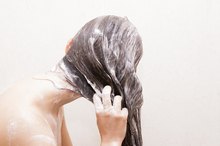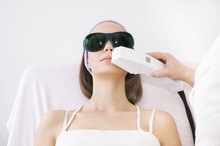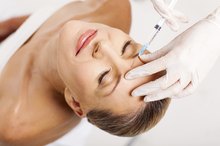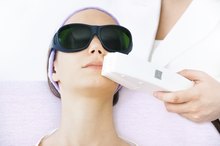Are There Any Side Effects of Using Rogaine for Hair Growth?
Rogaine is available in two strengths--2 percent and 5 percent, with the 5 percent product recommended only for men. Women tend to experience better results with the 5 percent product, but it can cause hair growth on the forehead. The higher-strength Rogaine also is more likely to cause side effects 1. Rogaine contains the active ingredient minoxidil, which is classified as a potassium channel opener medication.
Skin, Hair and Eyes Side Effects
The most common side effects associated with Rogaine include skin reactions and unwanted hair growth, as noted by Drugs.com 1. Some people experience dryness, scaling, eczema, itching, irritation or redness at the treated area. Side effects also may include increased facial hair growth, and changes in the texture or color of existing hair. Additionally, there have been reports of eye irritation or burning, and decreased visual clarity.
- The most common side effects associated with Rogaine include skin reactions and unwanted hair growth, as noted by Drugs.com 1.
- Side effects also may include increased facial hair growth, and changes in the texture or color of existing hair.
Allergic Reaction
Nioxin Side Effects
Learn More
Although unlikely, some people may experience an allergic reaction to Rogaine. Signs as listed by Drugs.com include:
- a rash or hives
- itching
- trouble breathing
- tightness in the chest,
- facial or mouth swelling
Development of these symptoms while using Rogaine should be considered a medical emergency. Symptoms similar to hay fever (allergic rhinitis) also are possible.
- Although unlikely, some people may experience an allergic reaction to Rogaine.
- Signs as listed by Drugs.com include: * a rash or hives
* itching
* trouble breathing
* tightness in the chest,
* facial or mouth swelling Development of these symptoms while using Rogaine should be considered a medical emergency.
Absorption Effects
Minoxidil is prescribed as an oral drug to lower high blood pressure. If a person applies too much topical Rogaine, excess absorption might occur, creating side effects associated with the oral drug 123. This is rare, but side effects due to absorption may include rapid weight gain and fluid retention in the ankles, lower legs, hands or stomach (edema). Other rare side effects due to minoxidil absorption, as listed by the Mayo Clinic include:
- chest pain
- changes in blood pressure
- rapid or irregular heartbeat
- heart palpitations
- headache
- dizziness
- faintness
- lightheadedness 234
An increase in body hair also could occur.
Gastrointestinal Effects
How to Use Sulfur Powder for Hair
Learn More
Some Rogaine users have reported gastrointestinal effects including diarrhea, nausea and vomiting, according to Drugs.com 1. These effects are rare and may be associated with drug absorption.
Related Articles
References
- Drugs.com: Rogaine Side Effects
- NIH: Topical Minoxidil Side Effects
- Mayo Clinic: Topical Minoxidil Side Effects
- Mayo Clinic: Oral Minoxidil Side Effects
- Pharmacia & Upjohn Company. Loniten minoxidil tablets, USP. Updated January 2015.
- No author listed. Topical minoxidil approved by FDA. Clin Pharm. 1988;7(12):858,862.
- Center for Drug Evaluation and Research. Application number: NDA 20-834. October 1, 1997.
- Ustuner ET. Cause of androgenic alopecia: crux of the matter. Plast Reconstr Surg Glob Open. 2013;1(7):e64. doi:10.1097/GOX.0000000000000005
- Suchonwanit P, Thammarucha S, Leerunyakul K. Minoxidil and its use in hair disorders: A review. Drug Des Devel Ther. 2019;13: 2777-86. doi:10.2147/DDDT.S214907
- Johnson & Johnson. Product monograph: Rogaine topicsal 2% solution: Minoxidil topical solution 20 mg/mL (2% w/v), Rogaine foam 5%: Minoxidil foam 50 mg/g (5% w/w), Women’s Rogaine foam 5%: Minoxidil Foam 50 mg/g (5%w/w). Updated July 20, 2014.
- Darwin E, Hirt PA, Fertig R, Doliner B, Delcanto G, Jimenez JJ. Alopecia areata: Review of epidemiology, clinical features, pathogenesis, and new treatment options. Int J Trichology. 2018;10(2):51-60. doi:10.4103/ijt.ijt_99_17
- Braam B, Taler SJ, Rahman M, et al. Recognition and management of resistant hypertension. Clin J Am Soc Nephrol. 2017;12(3):524-35. doi:10.2215/CJN.06180616
- Slove S, Lannoy M, Behmoaras J, et al. Potassium channel openers increase aortic elastic fiber formation and reverse the genetically determined elastin deficit in the BN rat. Hypertension. 2013;62(4):794-801. doi:10.1161/HYPERTENSIONAHA.113.01379
- Jimenez-Cauhe J, Saceda-Corralo D, Rodrigues-Barata R, et al. Effectiveness and safety of low-dose oral minoxidil in male androgenetic alopecia. J Am Acad Dermatol. 2019;81(2):648-9. doi:10.1016/j.jaad.2019.04.054
- Shah NH, Ruan DT. Pheochromocytoma: a devious opponent in a game of hide-and-seek. Circulation. 2014;130(15):1295-8. doi:10.1161/CIRCULATIONAHA.114.008544
- Rossi A, D'arino A, Pigliacelli F, et al. The diagnosis of androgenetic alopecia in children: Considerations of pathophysiological plausibility. Australas J Dermatol. 2019;60(4):e279-e283. doi:10.1111/ajd.13079
- Mundt HM, Matenaer M, Lammert A, et al. Minoxidil for treatment of resistant hypertension in chronic kidney disease--A retrospective cohort analysis. J Clin Hypertens (Greenwich). 2016;18(11):1162-7. doi:10.1111/jch.12847
Writer Bio
Shelley Moore is a journalist and award-winning short-story writer. She specializes in writing about personal development, health, careers and personal finance. Moore has been published in "Family Circle" magazine and the "Milwaukee Sentinel" newspaper, along with numerous other national and regional magazines, daily and weekly newspapers and corporate publications. She has a Bachelor of Science in psychology.









